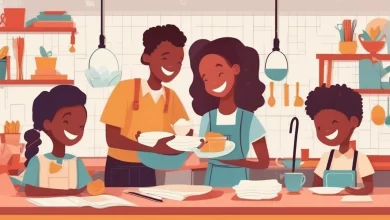Love Languages and Children: Parent-Child Connections

Every child speaks a unique emotional language. As parents, learning to decode and respond to these love languages can create lasting bonds and nurture emotional intelligence in our little ones.
You know that warm, fuzzy feeling when your kiddo spontaneously gives you a bear hug? Or maybe your heart melts when they craft a glitter-covered masterpiece “just for you”? Well, here’s the thing – your child might be speaking their love language, and it’s high time we became fluent in it!
The Five Love Languages in Child Development
Remember Dr. Gary Chapman’s groundbreaking work on love languages? While initially focused on adult relationships, these concepts have proven incredibly valuable in understanding our children’s emotional needs (Chapman & Campbell, 2016). Let’s dive into how these love languages manifest in kids – trust me, it’s not quite the same as with grown-ups!

Each child has their unique way of expressing and receiving love, and it’s absolutely fascinating how these preferences start showing up even in toddlerhood. Research from the Child Development Institute suggests that understanding these early patterns can significantly impact emotional development and self-esteem.
Words of Affirmation
When it comes to verbal appreciation, some kiddos are like little sponges soaking up every “I’m proud of you” and “You’re doing great!” But it’s not just about praise – it’s about being specific and genuine.
Dr. Laura Markham, a clinical psychologist, emphasizes that meaningful verbal affirmation can boost a child’s self-worth and resilience (Aha! Parenting, 2023). Try catching them being good and expressing your appreciation for their efforts, not just results.
Physical Touch
For some children, nothing says “I love you” quite like a warm hug or a gentle pat on the back. These physical connections aren’t just comforting – they’re essential for healthy development.
Research shows that appropriate physical touch releases oxytocin, often called the “bonding hormone,” which helps strengthen the parent-child relationship and promotes emotional security (American Psychological Association, 2023).

Identifying Your Child’s Primary Love Language
Wouldn’t it be amazing if kids came with instruction manuals? While they don’t, there are some pretty reliable ways to figure out their love language. Here’s what you’ll want to look out for:
- Watch how they express love to others – kids often give love in the way they prefer to receive it
- Pay attention to what they request most often (hugs, praise, time together, etc.)
- Notice what makes them feel most appreciated and valued
- Observe their reaction to different expressions of love
Age-Appropriate Love Language Expression
Boy, oh boy, does this get interesting as kids grow! A toddler’s love language might look completely different from a teenager’s, even if it’s technically the same one.
During the early years (ages 2-5), love languages tend to be more straightforward and physical. As children enter school age (6-11), their expression becomes more sophisticated, often incorporating elements of multiple love languages.

Creating Meaningful Connections Through Love Languages
Here’s where the rubber meets the road – putting this knowledge into action! Every parent I’ve worked with agrees that understanding their child’s love language was a game-changer, but implementing it consistently? That’s where the real magic happens.
Practical Applications for Different Age Groups
Different stages call for different strategies. What works for your preschooler might make your teen roll their eyes so hard they get stuck that way (just kidding, but you know what I mean!).
Frequently Asked Questions
Q: Can a child have more than one primary love language? A: Absolutely! While children often have a dominant love language, they may respond strongly to multiple forms of love expression.
Q: How often should I reassess my child’s love language? A: It’s recommended to observe and adjust your approach every 6-12 months, as preferences can shift during different developmental stages.
The Road Ahead: Making Love Languages Work for Your Family
As we wrap up this journey through love languages and child development, remember that this isn’t about perfection – it’s about connection. Your willingness to learn and adapt to your child’s emotional needs is what matters most.







